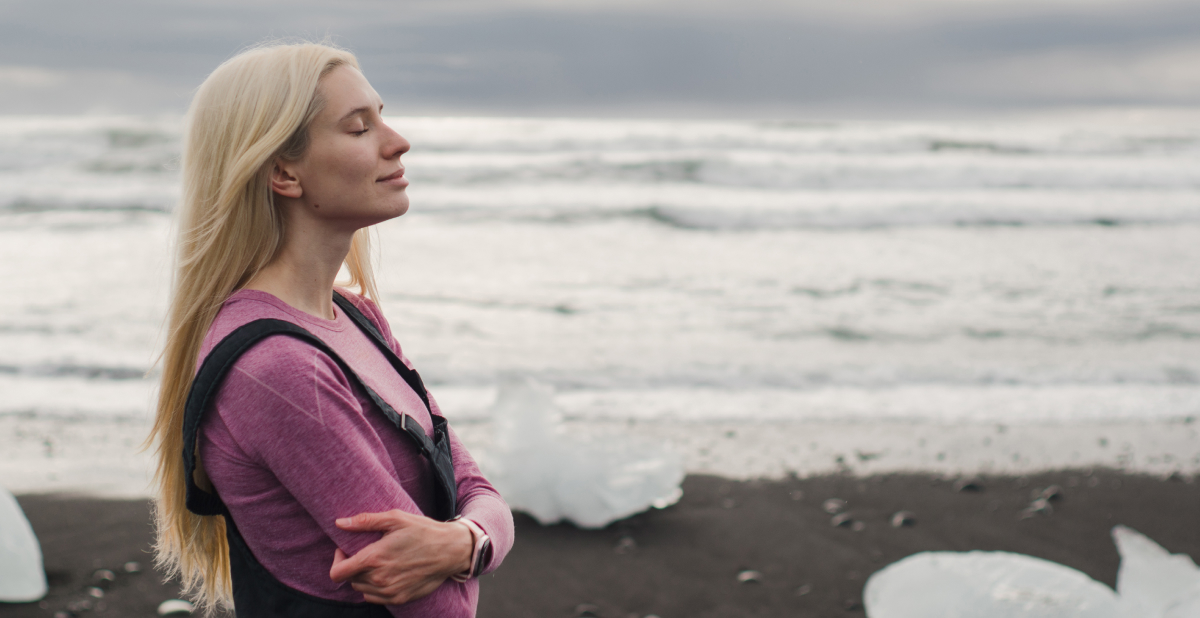From muggy heat to winter winds, climate has a powerful influence on your skin. Whether it’s the hot, dry desert air or steamy summer humidity, different weather conditions can shift your skin’s behavior—and its needs. You may notice your skin glowing and hydrated in some environments, while in others, it may feel dry, sensitive, or prone to breakouts. So how do you keep your glow, no matter the forecast?
It starts with understanding the skin exposome: the sum of internal and external factors that influence its health over time. Climate is one of the most impactful parts of that equation. Thankfully, with a few simple product swaps and self-care habits, you can support your skin through all kinds of weather conditions.
Let’s explore how different climates affect your skin—and how to adapt your skincare routine to match.
First things first: What is the exposome?
Every day, your skin is exposed to a variety of factors that shape how it looks and feels. Some are internal, like your stress levels and the amount of sleep you get. Others are external—such as UV rays, pollution, temperature, and weather changes.
This collection of influences is known as the exposome. And when it comes to external stressors, climate stands out. Changes in humidity, temperature, wind, and seasonal transitions can shift your skin’s oil levels, hydration, and sensitivity, making it essential to adapt your skincare through the seasons.
How does climate affect your skin?

Every type of climate presents its positives and negatives—for your lifestyle and skin. Depending on what the weather’s like where you live, here’s how it might affect the latter:
Hot and humid
Think coastal summers, lowland environments, or sticky heat waves. In these climates, excess moisture in the air can help reduce skin dryness—but may also increase oiliness, sweat, and clogged pores. Sweat and sebum build-up can trigger blemishes, especially in areas like the forehead, back, or chest. In fact, studies show that many people notice more breakouts and congestion during the hottest, most humid months.
Hot and dry
Desert-like heat pulls moisture from your skin, leading to rough patches, flaking, and increased sensitivity. You might even feel like your moisturizer “disappears” shortly after applying it. UV exposure is often stronger in this type of climate, which can speed up the appearance of fine lines, dark spots, and uneven tone. The combination of dryness and sun can also make skin feel tight, irritated, or even itchy.
Cold and dry
Winter air holds less moisture, and indoor heating often dries it out even more. The result? Chapped lips, dry hands, and flaky skin. Cold wind and quick temperature drops can also worsen sensitivity and conditions like rosacea or eczema. In some cases, redness and stinging sensations may increase as the skin barrier weakens from constantly battling harsh conditions.
Temperate and seasonal
If you live in a place with four seasons, your skin likely cycles through multiple challenges each year—from oiliness and sun spots in summer to dryness and flaking in winter. Transitional periods, like spring and fall, may also trigger temporary imbalances, such as allergy-related discomfort or sudden breakouts. This climate calls for routine updates to respond to what your skin is telling you.
Whatever the climate you live in, with the right skincare habits and a flexible approach, you can stay one step ahead and keep your skin looking and feeling its best.
Can heat accelerate skin aging?

Swap with last image? maybe she looks too happy about heat and aging? or I’m overthinking lol
You’ve seen how the weather affects your skin on a daily basis—more oiliness in humid environments, more dryness with the cold, and maybe even more sensitivity with seasonal changes. But there’s a less visible (yet equally important) effect tied to the environment: heat damage.
Beyond UV radiation
While UV rays are well-known for their aging effects, new studies show that heat—particularly prolonged exposure to high temperatures—can also take a toll on the skin over time. That’s because the sun also gives off another type of radiation: infrared.
We asked Isdinlover and dermatologist Dr. Latanya Benjamin to weigh in: “Studies suggest that infrared radiation (IR) can cause significant changes in the skin.” Such as? “Processes associated with premature skin aging.”
Emerging research shows that chronic exposure to high heat may contribute to the development of fine lines, wrinkles, and uneven tone—sometimes referred to as thermal aging. This happens as heat can compromise collagen and elastin fibers, the proteins that help keep skin firm and elastic.
Another thing to consider? When the skin is exposed to sustained heat, it can trigger an increase in melanin production, causing the potential for dark spots and uneven skin tone. This is especially common in hot, sunny climates where both UV and infrared heat are constantly present.
So, while your skin may feel dewy or plump in hot weather due to humidity, there may also be hidden stress happening beneath the surface. Not to worry—you can take a few simple steps to fight back.
How to help combat thermal aging
First, make sure to add a few supportive steps into your routine, staying cool when possible and protecting your skin barrier with gentle hydration. Dr. Benjamin reminds us of the most important step of all: sunscreen. “Incorporate a sun protector that not only guards against the harmful effects of solar radiation but also protects the skin from thermal damage,” she shares. What to look for? “Products that include antioxidants to neutralize free radicals from UV radiation and heat.”
New habits and the right sunscreen can go a long way in reducing the impact of heat-induced skin aging, helping your skin stay radiant, smooth, and resilient in the long run. “Your skin deserves complete protection. Shield it from the sun, and don’t forget the heat,” says Dr. Benjamin.
“Your skin deserves complete protection. Shield it from the sun, and don’t forget the heat.”
Dr. Latayna Benjamin
How to care for your skin in every climate

No matter where you live (or travel), a few climate-aware skincare tweaks can help you stay balanced, glowing, and comfortable. Here’s what to consider, depending on your surroundings:
In humid climates:
- Go lightweight: Use mineral oil-free or gel-style moisturizers to help hydrate without clogging pores. Look for fast-absorbing and mattifying formulas to control shine.
- Cleanse gently, but regularly: Sweat and oil can build up quickly, so washing twice a day is essential. While it might seem counterintuitive at first, an oil cleanser is a great option to melt away excess oils while keeping skin balanced.
- Stick to non-comedogenic products: Look for formulas that won’t block pores, especially if you’re prone to blemishes.
- Use an ultralight sunscreen: High SPF sunscreen is a must—even more so when paired with intense heat and humidity. But you can still opt for textures that don’t feel greasy.
- Shower and change clothes quickly after sweating: This can help prevent body breakouts and discomfort.
In dry climates:
- Layer hydration: Start with a hydrating serum with hyaluronic acid, then follow with a richer moisturizer to seal it in.
- Use a gentle, oil-based cleanser: Avoid anything that strips your natural oils or leaves your skin feeling tight.
- Try a humidifier indoors: It can add moisture to dry indoor air, especially in winter or inside heavily air-conditioned spaces.
- Apply SPF daily: Even in dry air, UV exposure can trigger pigmentation changes and the signs of premature aging. Opt for a moisturizing sunscreen with hyaluronic acid.
- Protect sensitive areas: Lips, hands, and around the eyes can dry out fastest—give them extra attention.
In cold climates:
- Moisturize often and immediately after cleansing: Trapping moisture in is key, especially when skin feels chapped or rough.
- Use balms or ointments for lips and hands: These areas often need extra protection throughout the day.
- Bundle up: Scarves, gloves, and a moisturizer for sensitive skin can help fight against discomfort and dryness on exposed skin.
- Avoid hot showers: Warm (not hot) water and short showers help preserve hydration and prevent barrier damage.
- Limit exfoliation: Overdoing it can cause irritation—once a week may be plenty in the cold months.
In seasonal climates:
- Switch products with the seasons: Think lighter in summer, richer in winter. Keep a few go-to options in your skincare cabinet.
- Watch for transitional periods: Autumn and spring can surprise your skin—adjust proactively based on how it feels.
- Stick with your essentials: Gentle cleansing, hydration, and daily sunscreen remain important year-round.
- Adjust active ingredients as needed: Think brightening serums in the fall (after summer sun leaves its mark) and gentle retinoids in winter (when you’re getting less sun)—adjusting exfoliation as needed.
Expert tip: Your dermatologist always knows best. If your skin suddenly feels uncomfortable or more sensitive, make an appointment when you can.
Your environment, your routine

Small shifts in your skincare routine can help your skin feel its best, wherever you are. And remember—a strong barrier, consistent hydration, and daily sun protection support healthy skin. Everyday habits (and exposome factors) such as getting enough sleep and managing stress can also make a big difference in how your skin responds to the climate around you.
So, whether it’s a crisp winter morning or a hot summer evening, give your skin what it needs to thrive. Healthy, beautiful skin is a journey—and adapting to your climate is one of the steps on the path to a vibrant complexion.

Amy is a content strategist who turned a part-time obsession with skincare into a full-time passion. Her experience as a creative storyteller includes a range of lifestyle and technology topics across Washington D.C. and Barcelona. What’s in her travel bag? Eye contour cream and sunscreen, always.
Source link




Add a Comment